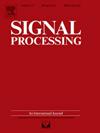Direction of arrival estimation for sparse arrays with gain-phase errors in nonuniform noise environment
IF 3.4
2区 工程技术
Q2 ENGINEERING, ELECTRICAL & ELECTRONIC
引用次数: 0
Abstract
The emerging sparse arrays achieve enhanced direction of arrival (DOA) estimation by flexibly deploying sensors and fully extracting the structural information contained in the incident sources. However, the existing DOA estimation algorithms for sparse arrays typically yield satisfactory performance only in ideal or single non-ideal scenarios. In this work, we address the issue of DOA estimation for sparse arrays under the coexistence of gain-phase errors and nonuniform noise. The analysis of the negative impact of these two types of non-idealities on virtual array processing motivates us to develop new algorithm. Specifically, with the perturbation of gain-phase errors, a least squares optimization program is first constructed to solve the nonuniform noise power. Then, based on the initial gain errors obtained by exploiting the diagonal entries in the denoised covariance matrix, we implement the iterative estimation of DOAs and gain-phase errors with the aid of the eigenstructure-based subspace approach. To improve the DOA estimation accuracy, we formulate the difference coarray interpolation problem and introduce the truncated nuclear norm minimization to recover the missing information. The developed algorithm can overcome the effects of gain-phase errors and nonuniform noise simultaneously. Numerical simulations demonstrate that the developed algorithm outperforms its competitors.
非均匀噪声环境下增益相位误差稀疏阵列的到达方向估计
新兴的稀疏阵列通过灵活部署传感器和充分提取入射源中包含的结构信息,实现了增强的到达方向估计。然而,现有的稀疏阵列DOA估计算法通常仅在理想或单一非理想场景下才能获得令人满意的性能。在这项工作中,我们解决了增益相位误差和非均匀噪声共存下稀疏阵列的DOA估计问题。分析了这两类非理想性对虚拟阵列处理的负面影响,激励我们开发新的算法。具体而言,考虑增益相位误差的扰动,首先构造最小二乘优化程序求解非均匀噪声功率。然后,利用去噪协方差矩阵的对角线项得到初始增益误差,借助基于特征结构的子空间方法实现doa和增益相位误差的迭代估计。为了提高DOA估计精度,我们提出了差分阵插值问题,并引入截断核范数最小化来恢复缺失信息。该算法能同时克服增益相位误差和非均匀噪声的影响。数值仿真结果表明,该算法优于同类算法。
本文章由计算机程序翻译,如有差异,请以英文原文为准。
求助全文
约1分钟内获得全文
求助全文
来源期刊

Signal Processing
工程技术-工程:电子与电气
CiteScore
9.20
自引率
9.10%
发文量
309
审稿时长
41 days
期刊介绍:
Signal Processing incorporates all aspects of the theory and practice of signal processing. It features original research work, tutorial and review articles, and accounts of practical developments. It is intended for a rapid dissemination of knowledge and experience to engineers and scientists working in the research, development or practical application of signal processing.
Subject areas covered by the journal include: Signal Theory; Stochastic Processes; Detection and Estimation; Spectral Analysis; Filtering; Signal Processing Systems; Software Developments; Image Processing; Pattern Recognition; Optical Signal Processing; Digital Signal Processing; Multi-dimensional Signal Processing; Communication Signal Processing; Biomedical Signal Processing; Geophysical and Astrophysical Signal Processing; Earth Resources Signal Processing; Acoustic and Vibration Signal Processing; Data Processing; Remote Sensing; Signal Processing Technology; Radar Signal Processing; Sonar Signal Processing; Industrial Applications; New Applications.
 求助内容:
求助内容: 应助结果提醒方式:
应助结果提醒方式:


